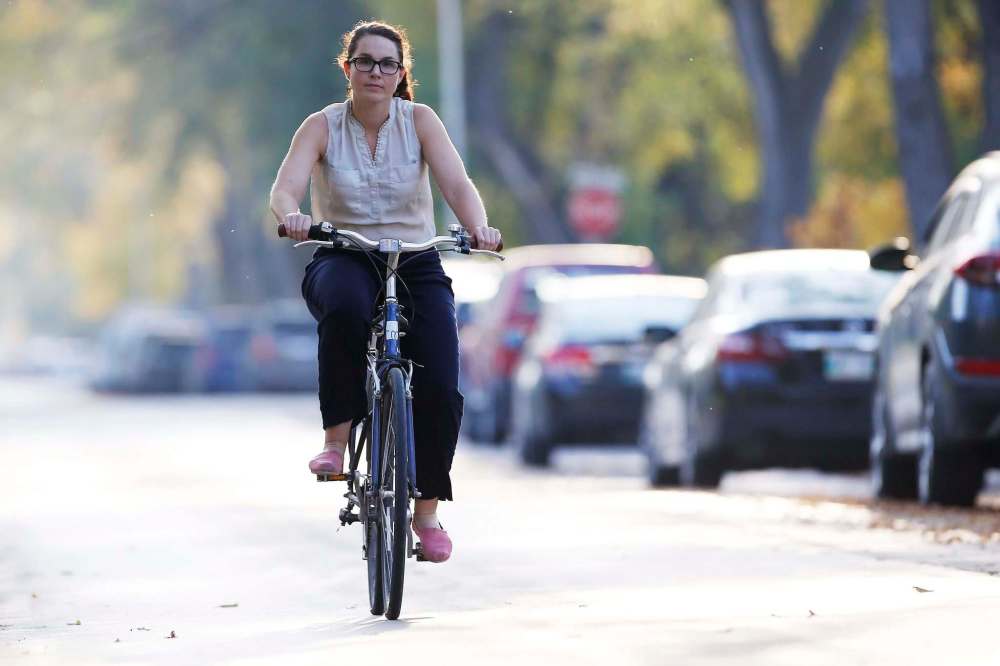Boost to cycling options peddled
Councillor wants 2022 budget to increase funding for green transportation
Advertisement
Read this article for free:
or
Already have an account? Log in here »
To continue reading, please subscribe:
Monthly Digital Subscription
$0 for the first 4 weeks*
- Enjoy unlimited reading on winnipegfreepress.com
- Read the E-Edition, our digital replica newspaper
- Access News Break, our award-winning app
- Play interactive puzzles
*No charge for 4 weeks then price increases to the regular rate of $19.00 plus GST every four weeks. Offer available to new and qualified returning subscribers only. Cancel any time.
Monthly Digital Subscription
$4.75/week*
- Enjoy unlimited reading on winnipegfreepress.com
- Read the E-Edition, our digital replica newspaper
- Access News Break, our award-winning app
- Play interactive puzzles
*Billed as $19 plus GST every four weeks. Cancel any time.
To continue reading, please subscribe:
Add Free Press access to your Brandon Sun subscription for only an additional
$1 for the first 4 weeks*
*Your next subscription payment will increase by $1.00 and you will be charged $16.99 plus GST for four weeks. After four weeks, your payment will increase to $23.99 plus GST every four weeks.
Read unlimited articles for free today:
or
Already have an account? Log in here »
Hey there, time traveller!
This article was published 01/10/2021 (1508 days ago), so information in it may no longer be current.
The public works committee chairman is calling for a major increase to the City of Winnipeg’s active transportation spending.
Coun. Matt Allard wants the 2022 budget process to consider such funding that equals 10 per cent of the annual road construction budget. The investment could build up cycling and pedestrian routes, which would help reduce greenhouse gas emissions and combat climate change, he says.
“Every year, we emit more and more carbon, and we need to find ways to reduce the amount of carbon that we’re putting into the atmosphere,” Allard said Thursday. “In order to make (Winnipeg’s) climate action plan deliver what it intends to, we need to add that meat on the bones to ensure we (complete the active transportation network).”

At $1.7 million, dedicated spending for active transportation falls far below that amount in 2021, with a roads budget of $152 million. If Allard’s change is approved for 2022, it would increase the AT budget from a forecast $2.3 million to $16.2 million (based on a projected road budget of $162 million).
The St. Boniface councillor said some AT spending occurs separately within specific road projects. But he said many road renewals don’t include it, including 2021 projects at Roblin Boulevard and Day Street.
Allard also wants council to make active transportation investments eligible for revenue raised through annual tax hikes.
Mayor Brian Bowman has promised to cap the property tax hike at 2.33 per cent again in 2022, with two per cent earmarked for roads and bridges and 0.33 per cent for rapid transit.
Allard said increased AT funding would help the city ensure half of all local trips involve greener modes of transportation than single-passenger vehicles by 2030, one of its key climate change goals.
“For every bicycle used in a commute, that’s one less car on the road,” said Allard.
The proposed funding hike is welcome but meets the minimum investment needed for cycling and pedestrian routes, said Mel Marginet, a workplace commuter options co-ordinator at the Green Action Centre.
“That will give us a fighting chance to move forward on the pedestrian and cycling strategies that the city already has,” said Marginet.
In 2015, city council approved a 20-year, $334-million cycling and pedestrian strategy but actual investments have delayed its implementation.
With roughly 80 per cent of Winnipeggers choosing personal vehicles for their trips, much more investment is needed to make the green transportation options of walking, biking and bussing more convenient, said Marginet.
“It’s really a shift in the paradigm… At this current time, cars go first (in budget priority).”
Mark Cohoe, executive director of Bike Winnipeg, said active transportation has been persistently underfunded in recent years, which leaves gaps in cycling routes.
“(The current budget is) really just a fraction of what’s been needed… We see it in an unconnected network,” said Cohoe, adding the extra funding would spark a huge improvement.
Coun. Janice Lukes, a former public works chairwoman, said she supports Allard’s proposals. However, she said he and other executive policy committee members should never have allowed the AT budget to drop to its current level.
“We would have been much further ahead (on active transportation) at this time (if they hadn’t),” said Lukes. “It’s gone down millions.”
In 2019, for example, the preliminary budget included $3 million for active transportation, down from a previously forecast $5.7 million.
The current forecast predicts the funding will drop to $1.7 million in 2023, and $1.4 million per year from 2024 to 2026.
Allard said provincial funding cuts played a role in the reduced investment in recent years.
His motions will be considered by council’s public works committee Oct. 12.
joyanne.pursaga@freepress.mb.ca
Twitter: @joyanne_pursaga

Joyanne is city hall reporter for the Winnipeg Free Press. A reporter since 2004, she began covering politics exclusively in 2012, writing on city hall and the Manitoba Legislature for the Winnipeg Sun before joining the Free Press in early 2020. Read more about Joyanne.
Every piece of reporting Joyanne produces is reviewed by an editing team before it is posted online or published in print — part of the Free Press‘s tradition, since 1872, of producing reliable independent journalism. Read more about Free Press’s history and mandate, and learn how our newsroom operates.
Our newsroom depends on a growing audience of readers to power our journalism. If you are not a paid reader, please consider becoming a subscriber.
Our newsroom depends on its audience of readers to power our journalism. Thank you for your support.

